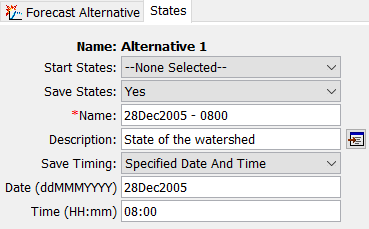Download PDF
Download page Forecast Alternatives.
Forecast Alternatives
Streamflow forecasting typically includes simulation of past and future conditions. The process begins with the Selection of a Time of Forecast. Typically the time of forecast represents the last available time for meteorologic observations of precipitation, temperature, and other variables. If observations of streamflow, stage, or reservoir pool elevation are available, the last available value is also generally near the time of forecast. The simulation is started hours or days before the time of forecast. Results computed between the start time and the forecast time may be called the Look Back Period. When observations of current watershed conditions are available, they may be compared with computed results from the look back period to make calibration adjustments that improve model performance. Meteorologic observations are not available after the time of forecast and predictions of future values are used. For example, a Quantitative Precipitation Forecast (QPF) provides a meteorologic prediction of future precipitation depths. Similar predictions are used for other meteorologic variables such as temperature. The future streamflow response is simulated based on the predicted meteorologic conditions. This period of time in the future may be called the Forecast.
Time is often of the essence when performing streamflow forecasting and modeling techniques must consider this fact. During the development of a forecast it is common to group similar subbasins together and apply parameter adjustments across each group. This is supported in Forecast Alternatives through the use of Zones. Creating Zones is described in Zones. Zones are used in a Forecast Alternative to quickly set parameter adjustments when a group of subbasins have similar conditions. A parameter adjustment is entered once and applied to all of the subbasins in the Zone. A local element override can be used if a subbasin within a Zone diverges in behavior from the rest of the subbasins in that same Zone.
Forecast Alternatives are one of the components that can compute results. Each alternative is composed of a Basin Model, Meteorologic Model, and Time Control Information. The alternative also includes Zone Configurations for loss rate, transform, baseflow, and reach routing parameters. The alternative may optionally include blending at elements with observed flow. Results are available at each element after the simulation is complete.
A Forecast Alternative is constructed using the same initial conditions and parameters found in the Basin Model selected in the Forecast Alternative. Then the parameter adjustments specified for each zone replace the values taken from the Basin Model, with each subbasin or reach in the zone receiving the same parameter adjustment. Any local element overrides are applied after zone adjustments. Initial baseflow may then be set using observed flow and reservoir pool elevations set using observed stage. Also, initial reach outflow may then be set using observed flow. Next, results are computed using the adjusted parameter values and the selected Meteorologic Model. Finally the computed results are adjusted at elements with observed flow and where blending has been selected.
It is often necessary to prepare multiple forecasts with the same time of forecast. The multiple forecasts provide alternative estimates of future conditions under different scenarios or assumptions. For example, multiple alternatives could be used to explore the effect of different assumptions about the soil moisture state of the watershed at the beginning of the look back period. In another example, several alternatives could be used to explore the range of potential future flows depending on the amount of future precipitation. One more example would be the development of multiple alternatives with different reservoir release schedules in order to evaluate the impact of releases on downstream flows. Results from all considered alternatives can be used as part of a decision support system to determine how reservoirs should be operated, or to issue emergency flood warnings.
Creating a New Forecast Alternative
A new Forecast Alternative is created using a wizard that helps you navigate the steps to creating a new alternative. There are two ways to access the wizard. The first way to access the wizard is to click on the Compute menu and select the Create Compute | Forecast Alternative command; it is only enabled if at least one Basin Model and Meteorologic Model exist. The wizard will open and begin the process of creating a new Forecast Alternative. The second way to access the wizard is from the Forecast Alternative Manager. Click on the Compute menu and select the Forecast Alternative Manager command. The Forecast Alternative Manager will open and show any alternatives that already exist. Press the New button to access the wizard and begin the process of creating a Forecast Alternative, as shown below.
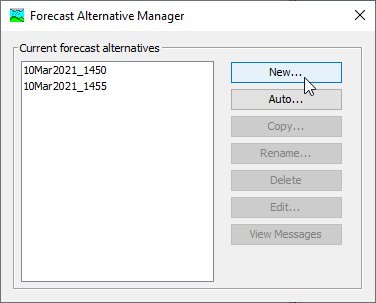
The first step of creating a Forecast Alternative is to provide the name for the new alternative (shown below). A default name is provided for the new Forecast Alternative; you can use the default or replace it with your own choice. After you finish creating the alternative you can add a description to it. If you change your mind and do not want to create a new Forecast Alternative, you can press the Cancel button at the bottom of the wizard or the X button in the upper right corner of the wizard. The Cancel button can be pressed at any time you are using the wizard. Press the Next button when you are satisfied with the name you have entered and are ready to proceed to the next step.
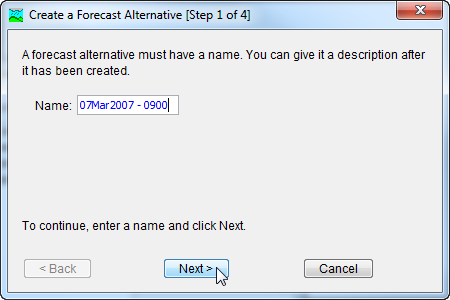
The second step of creating a Forecast Alternative is to select a Basin Model. All of the Basin Models that are currently part of the project are displayed in alphabetical order. By default the first Basin Model in the table is selected. The selected Basin Model is highlighted. You can use your mouse to select a different Basin Model by clicking on it in the table of available choices. You can also use the arrow keys on your keyboard to select a different Basin Model. Press the Next button when you are satisfied with the Basin Model you have selected and are ready to proceed to the next step. Press the Back button if you wish to return to the previous step and change the name for the new Forecast Alternative.
The third step of creating a Forecast Alternative is to select a Meteorologic Model. All of the Meteorologic Models that are currently part of the project are displayed in alphabetical order. By default the first Meteorologic Model in the table is selected. The selected Meteorologic Model is highlighted. You can use your mouse to select a different Meteorologic Model by clicking on it in the table of available choices. You can also use the arrow keys on your keyboard to select a different Meteorologic Model. You are responsible for selecting a Basin Model in step two and a Meteorologic Model in this step that will successfully combine to compute results. Press the Next button when you are satisfied with the Meteorologic Model you have selected and are ready to proceed to the next step. Press the Back button if you wish to return to the previous step and select a different Basin Model for the Forecast Alternative.
The fourth step of creating a Forecast Alternative is to select a Time Interval and Zone Configurations. The time interval must be selected from among the available choices. The default selection is 15 minutes, but you may choose any of the available intervals. You may also select the Zone Configuration to use for loss rate adjustments, transform adjustments, baseflow adjustments, and routing adjustments. The selection list includes all of the Zone Configurations available in the Basin Model that was selected in step two. You may use a different Zone Configuration for each type of adjustment. Alternately, you may use the same Zone Configuration for loss rate, transform, baseflow, and routing adjustments. Press the Finish button when you are satisfied with the name you have entered, the Basin Model and Meteorologic Model you selected, and are ready to create the Forecast Alternative. Press the Back button if you wish to return to the previous step and select a different Meteorologic Model.
Creating a New Automated Forecast
The Automated Forecast option automatically pulls data from the web, and generates a continuous forecast with look back period data and forecast period data. As of v.4.9 the Automated Forecast option only references data sources for the Continental United States. The Automated Forecast requires a connection to the web. To run the Automated Forecast, you must have Basin Model with spatial elements (subbasin elements must be georeferenced). Subbasin elements must use a structured or unstructured discretization methods. The Basin Model should also be configured for continuous simulation. The figure below shows the Automated Forecast option from the Forecast Alternative Manager.
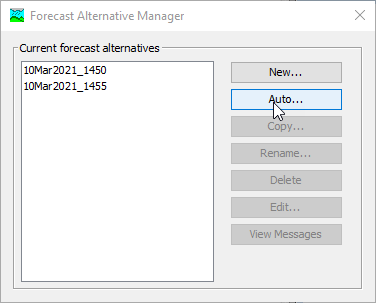
On the first step of the Automated Forecast Wizard (shown below), a Name is selected by the user. A default name is provided that corresponds with the time that the first wizard step was accessed. If the format of the automatically generated name is maintained, the forecast and all related project components can be deleted with a single click.
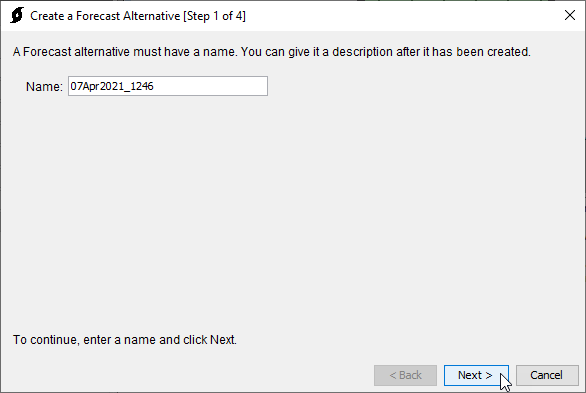
On the second step of the Automated Forecast Wizard (shown below), a Basin Model is selected. In the Basin Model, Subbasin Elements must use the structured or unstructured discretization methods. The Basin Model should also be configured for continuous simulation.
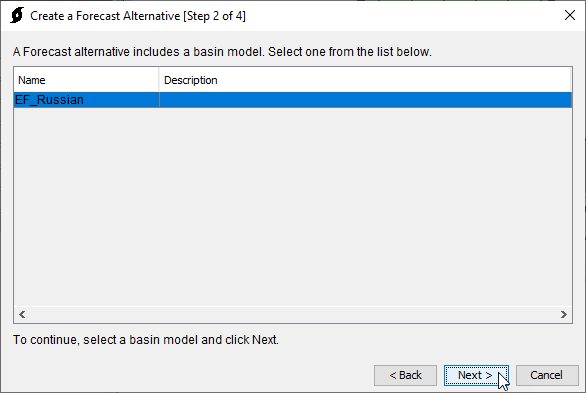
If a valid USGS Station ID has been specified for discharge gages within the Basin Model, the Automated Forecast will attempt to retrieve the latest flow data at that location. The figure below shows a station ID specified for a USGS stream gage location.
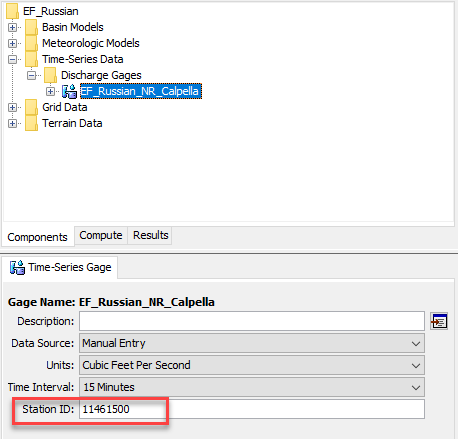
On the third step of the Automated Forecast Wizard (shown below), look back period data is selected. At least one data source must be selected to proceed.
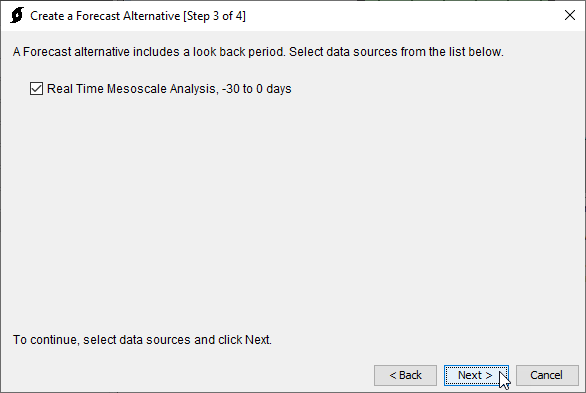
On the fourth step of the Automated Forecast Wizard (shown below), Forecast Period Data is selected. At least one data source must be selected to proceed. If more than one dataset is selected, datasets will be merged based on their precedence. Datasets are listed from top to bottom in order of highest to lowest spatial and temporal resolution. Datasets with highest spatial and temporal resolution are given precedence when merging.
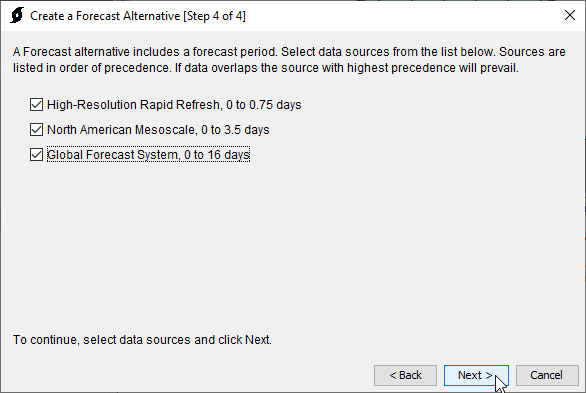
After selecting Next on the fourth step of the wizard, the Automated Forecast will begin downloading data from the web. This can take up to several minutes depending on the size of the basin. The Automated Forecast will merge datasets to create a continuous boundary condition. Precipitation and temperature gridsets will be created with the same name as the forecast. A met model will be created with the same name as the forecast and linked to the selected Basin Model. A new forecast will be created with the name of the Automated Forecast. The data that is downloaded to run the forecast can be found in the Data subdirectory of the project.
Copying a Forecast Alternative
There are two ways to copy a Forecast Alternative. Both methods for copying a trial create an exact duplicate with a different name. Once the copy has been made it is independent of the original and they do not interact.
The first way to create a copy is to use the Forecast Alternative Manager, which is accessed from the Compute menu. Select the Forecast Alternative you wish to copy by clicking on it in the list of current Forecast Alternatives. The selected alternative is highlighted after you select it. After you select an alternative you can press the Copy button on the right side of the window. The Copy Forecast Alternative window (shown below) will open where you can name and describe the copy that will be created. A default name is provided for the copy; you can use the default or replace it with your own choice. A description can also be entered; if it is long you can use the button to the right of the description field to open an editor. When you are satisfied with the name and description, press the Copy button to finish the process of copying the selected Forecast Alternative. You cannot press the Copy button if no name is specified. If you change your mind and do not want to copy the selected Forecast Alternative, press the Cancel button or the X button in the upper right to return to the Forecast Alternative Manager window.
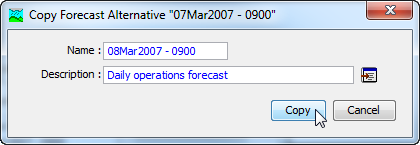
The second way to copy is from the Compute tab of the Watershed Explorer. Move the mouse over the Forecast Alternative you wish to copy and press the right mouse button (shown below). A context menu is displayed that contains several choices including Copy. Click the Create Copy command. The Copy Forecast Alternative window will open where you can name and describe the copy that will be created. A default name is provided for the copy; you can use the default or replace it with your own choice. A description can also be entered; if it is long you can use the button to the right of the description field to open an editor. When you are satisfied with the name and description, press the Copy button to finish the process of copying the selected Forecast Alternative. You cannot press the Copy button if no name is specified. If you change your mind and do not want to copy the selected Forecast Alternative, press the Cancel button or the X button in the upper right of the Copy Forecast Alternative window to return to the Watershed Explorer.
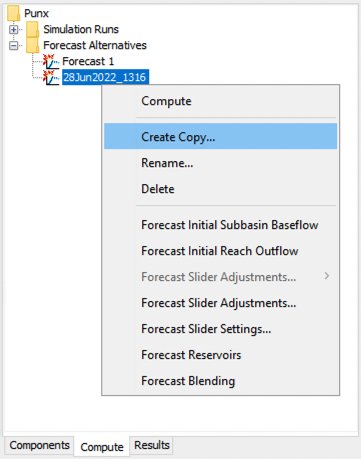
Renaming a Forecast Alternative
There are two ways to rename a Forecast Alternative. Both methods for renaming an alternative change its name and perform other necessary operations.
The first way to perform a rename is to use the Forecast Alternative Manager, which you can access from the Compute menu. Select the Forecast Alternative you wish to rename by clicking on it in the list of current alternatives. The selected alternative is highlighted after you select it. After you select an alternative you can press the Rename button on the right side of the window. The Rename Forecast Alternative window (shown below) will open where you can provide the new name. If you wish you can also change the description at the same time. If the new description will be long, you can use the button to the right of the description field to open an editor. When you are satisfied with the name and description, press the Rename button to finish the process of renaming the selected Forecast Alternative. You cannot press the Rename button if no name is specified. If you change your mind and do not want to rename the selected Forecast Alternative, press the Cancel button or the X button in the upper right of the Rename Forecast Alternative window to return to the Forecast Alternative Manager window.
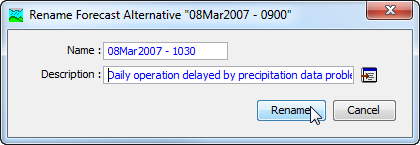
The second way to rename is from the Compute tab of the Watershed Explorer. Select the Forecast Alternative you wish to rename by clicking on it in the Watershed Explorer; it will become highlighted. Keep the mouse over the selected alternative and click the left mouse button again. The highlighted name will change to editing mode (shown below). You can then move the cursor with the arrow keys on the keyboard or by clicking with the mouse. You can also use the mouse to select some or all of the name. Change the name by typing with the keyboard. When you have finished changing the name, press the Enter key to finalize your choice. You can also finalize your choice by clicking elsewhere on the Compute tab. If you change your mind while in editing mode and do not want to rename the selected Forecast Alternative, press the Escape key.
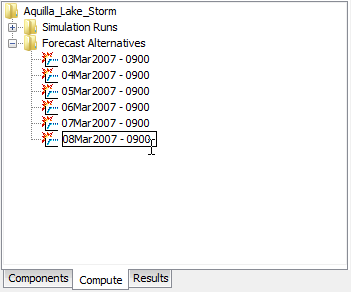
Deleting a Forecast Alternative
There are two ways to delete a Forecast Alternative. Both methods for deleting an alternative remove it from the project and automatically delete previously computed results. Once an alternative has been deleted it cannot be retrieved or undeleted.
The first way to perform a deletion is to use the Forecast Alternative Manager, which you can access from the Compute menu. Select the Forecast Alternative you wish to delete by clicking on it in the list of current alternatives. The selected alternative is highlighted after you select it. After you select an alternative you can press the Delete button on the right side of the window. A window will open where you must confirm that you wish to delete the selected alternative as shown below. Press the OK button to delete the alternative. If you change your mind and do not want to delete the selected Forecast Alternative, press the Cancel button or the X button in the upper right to return to the Forecast Alternative Manager window.
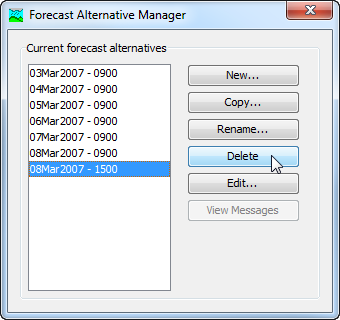
The second way to delete is from the Compute tab of the Watershed Explorer. Select the Forecast Alternative you wish to delete by clicking on it in the Watershed Explorer; it will become highlighted (shown below). Keep the mouse over the selected alternative and click the right mouse button. A context menu is displayed that contains several choices including delete. Click the Delete command. A window will open where you must confirm that you wish to delete the selected alternative. Press the OK button to delete the alternative. If you change your mind and do not want to delete the selected Forecast Alternative, press the Cancel button or the X button in the upper right to return to the Watershed Explorer.
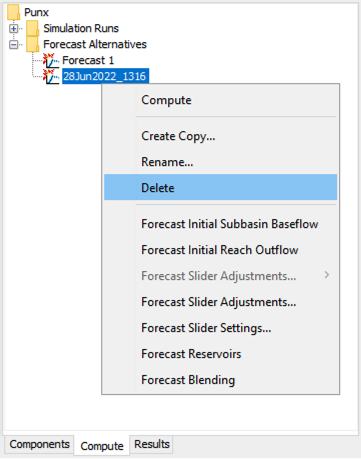
Selecting Components
One of the principal tasks when creating a Forecast Alternative using the wizard is the selection of the components that will be used to compute forecast results. The components include the Basin Model and the Meteorologic Model. These components are selected when creating a new Forecast Alternative with the wizard. However, you can change the Basin Model and Meteorologic Model you wish to use at any time using the Component Editor for the Forecast Alternative. Access the Component Editor from the Compute tab of the Watershed Explorer (shown below). If necessary, click on the Forecast Alternatives folder to expand it and view the available Forecast Alternatives. The Component Editor contains a Basin Model selection list that includes all of the Basin Models in the project. The Component Editor also contains a Meteorologic Model selection list that includes all of the Meteorologic Models in the project.
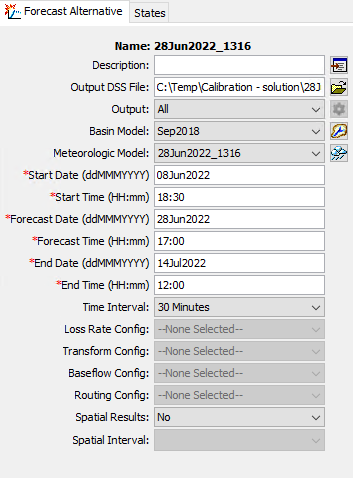
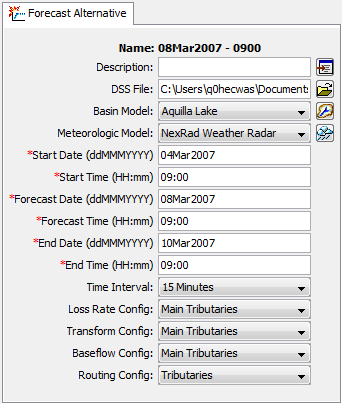
Entering a Time Window
You must enter a Start Date and Time, a Forecast Date and Time, and an End Date and Time for the Forecast Alternative. The time control information is not specified in the wizard used to create the Forecast Alternative. The time control information must be entered after the alternative is created using the Component Editor for the Forecast Alternative. Enter the start date using the indicated format for numeric day, abbreviated month, and four-digit year. Enter the forecast date and end date using the same format. The start time, forecast time, and end time are entered using 24-hour time format. Choose a time interval from the available options which range from 1 minute up to 1 day. Finally, the start time, forecast time and end time must all be an integer number of time intervals after the beginning of the day.
Selecting Zone Configurations
Zone Configurations are used to make parameter adjustments in a Forecast Alternative. A Zone Configuration is defined in the Basin Model and the Basin Model may contain more than one Zone Configuration. Each Zone Configuration contains either subbasin or reach elements but not both types of elements. In turn, each Zone Configuration contains one or more zones. All of the subbasins or reaches in the Basin Model should be assigned to a zone. The Zone Configuration is selected using the Component Editor for the Forecast Alternative. A Zone Configuration can be selected for setting the lossrate adjustments, the transform adjustments, the baseflow adjustments, and the routing adjustments. A different Zone Configuration may be used for each selection, or the same Zone Configuration may be used more than once. No parameter adjustments can be performed until Zone Configuration selections are made.
Start and Save States
The various mathematical equations used in the Basin and Meteorologic Models all contain State Variables. A state variable is simply the current condition of the system at the end of a time interval. For example, the state variable in a reservoir is the amount of water in storage, usually measured as an elevation. In the soil moisture accounting loss method, the state variable is the amount of water currently held in each of the layers. The state variables change during a simulation in response to changing boundary conditions and the dynamics of the mathematical equation governing the method.
The State Variables all must be specified at the beginning of a simulation, in which case they are called Initial Conditions. Some methods allow you to specify the value you wish to use, such as the initial storage in a reservoir. Some methods implicitly specify the initial condition, for example loss methods that allow you to specify the amount of infiltration that must occur before surface runoff begins, often called the initial loss. Many of the channel routing methods assume the initial condition that initial outflow equals the first inflow to the reach, or the user can specify the initial outflow.
States have two main purposes: Breaking Long Simulations into Smaller Time Periods, and Real-Time Forecasting Operations. In the second case of real-time forecasting operations, the typical approach is often to compute a simulation run daily and forecast three to five days into the future. The simulation can be configured to run for five days, saving the state variables at the end of the first day. When the forecast is updated on the subsequent day, it can start from the saved states of the previous day and continue forward. In this way, continuously updated results can be obtained without requiring the simulation to start at the last known watershed conditions which might be very old.
Saving out the start state variables during a Forecast Alternative, or starting a run from saved state variables is optional. If you do not use saved state variables (start states), then the initial conditions will be specified from the Basin and Meteorologic Models. If you do use the start states, the initial conditions specified in the Basin and Meteorologic Models will be overridden by the values contained in the saved states used as the start states. If you do not use save states, the Forecast Alternative will run normally. If you do choose to save states, the Forecast Alternative will pause momentarily to save the state variables and then continue normally. The save states condition (file) that is created can be used for any Forecast Alternative, the start date of the Forecast Alternative does not have to be similar to the date when the save states were created. The save states can be used across different Forecast Alternative runs, but you must make sure the Basin and Meteorologic Models have similar configurations (similar elements in the Basin Model and similar modeling methods in the Basin and Meteorologic Models) in order for the save states to be applicable.
Selecting optional start states for the Forecast Alternative is accessed from the Compute tab of the Watershed Explorer. Open the Component Editor for the Forecast Alternative and then click on the States tab (shown below). The States tab is always shown whenever the Forecast Alternative Component Editor is shown. You can choose to save states and start the Forecast Alternative with existing saved states. Start the simulation with saved states by choosing the states you wish to use from the Start States selection list. Only states saved by running a Forecast Alternative configured to save states are shown. You will not be able to select start states unless there are valid states available. A descriptive save states name can be helpful when selecting the states to start a simulation. For example, a name of 28Dec2005 - 0800 was used when saving states when creating the example shown below. The date and time the states were saved were used for the name to aid in choosing these saved states in subsequent Forecast Alternatives.
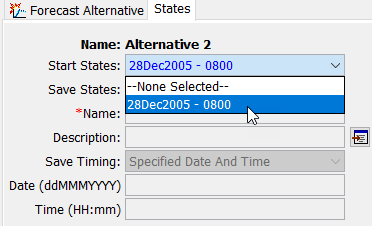
Creating optional save states for the Forecast Alternative is accessed from the Compute tab of the Watershed Explorer. Open the Component Editor for the simulation run and then click on the States tab (shown below). The States tab is always shown whenever the Component Editor is shown. To create a save states file, you must change the Save States option from No to Yes, as shown below. You must specify a Name for the save states and optionally may enter a Description. There are three ways to specify when the states will be saved: At the End of the Simulation Run, At the Time of Forecast, or At a Specified Date and Time During the Forecast Alternative. If you select to save states at the end of the run or at the time of forecast, the program will automatically determine the correct date and time to save states. If you select to save states at a specific time, you must enter the date and time. The specified date and time must be after the start and either at or before the end of the simulation run.
A Forecast Alternative contains many tools for modifying initial conditions and parameters in the Basin Model. These tools include Zonal Editors, Parameter Override Editors, Slider Bar Editors, and Initialization Editors. Initial conditions pulled from the save states file will overwrite the initial conditions and parameter adjustments computed by the Zonal Editors, Parameter Override Editors, and Slider Bar Editors. Initial conditions computed by the Initialization Editors will overwrite initial conditions pulled from the save states file.
